Protecting Coral Reefs and Cleaning the Ocean
During this activity, participants will learn about coral reefs and why plastic pollutants are damaging their ecosystems. Working in small groups or in pairs, the participants will build a game to simulate cleaning the oceans from plastic debris. The goal is to remove the “pollutants” without perturbing the fauna and flora living in the ocean, especially the coral reefs. They will use a Makey Makey and the program Scratch to build and play the game.
Intended Audience: Grades K-12
Duration: 60-90 minutes
With this hands-on activity, participants will explore the applications of STEM and life in the ocean, improving their collaboration and teamwork, creativity, critical thinking and problem solving skills.
Developed by Actua’s network member uOttawa Engineering Outreach, University of Ottawa.
Activity Procedure
To Do in Advance
- Make sure all the computers are working and connected to Scratch.mit.edu.
- Each pair should have 1 Makey Makey and 3 alligator clips. Plug in the Makey Makey using the USB to the computer.
Opening Hook
Show this picture to the participants and ask them…What do you see? Is there something wrong? Is there any object that you see that is out of place?
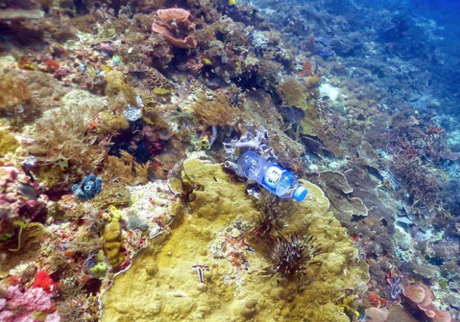
Explain the purpose of the activity: Today, we will act as marine biologists and environmental engineers and we will try to clean up the coral reef from all the plastic waste caught in it. We want to be as gentle as possible and avoid touching the coral and perturbing it. We will make our own small coral reef and build a game where we have to remove the plastic waste without touching the coral.
Activity 1 : Preparing the Coral reef and making tweezers
- Distribute materials to participants (piece of 8” x 11” cardboard, sheet of paper, markers, scissors, 2 cups and aluminum paper, 2 wooden rods and 2 elastics, and construction paper strip).
- Working in pairs, tell the participants to draw a coral reef on the piece of paper and choose two spots where plastic waste will be found and should be removed. They should draw a circle at those two locations, using the red solo cup as a guide to trace. These two circles will be cut off afterward.
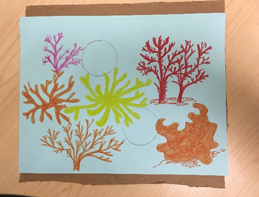
- Glue the piece of paper on top of the cardboard. With scissors, cut off the two circles to make two holes, slightly smaller than the two drawn circles.
- Line each of the shot cups with foil, with a decent amount overflowing at the top. Tape each cup underneath the holes in the cardboard.

- To make the tweezers, using the foil, wrap each of the wooden rods with about two layers of foil. Make sure at least one end of each rod is covered. Make it as tight as possible.
- Roll up a strip of construction paper (about 12.5 cm long and 5 cm wide).
- Put the rolled-up paper between the two rods. Using one elastic band, wrap it around the short side of the rods. Repeat until the elastic is taut. Using the other elastic, wrap it around one end of the roll, twist it and bring it over the rods (parallel to the rods), twist it again, and wrap it around the other end of the roll. Repeat until the elastic is taut.
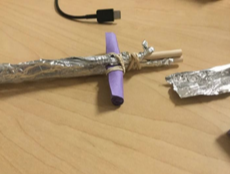
Activity 2: Write the program in Scratch and connect Makey Makey
Connect the Makey Makey
On the Makey Makey, connect one wire to the space key. Connect the wire from the space to the tweezers.
Also have two wires clipped to the ground sections. Connect each ground wire to the foil overflowing from each of the two shot cups.
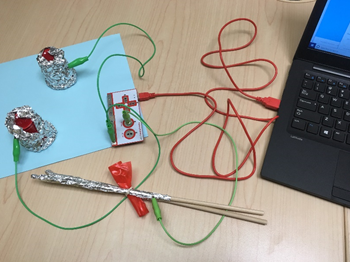
Build the program in Scratch
Either open the program already built in Scratch, or make your own! You start with 10 lives. Every time the space bar is pressed (this will happen when the tweezers touch the aluminum foil in the cup), you will hear a sound and lose 1 life. When you lost 10 lives, the game is over. The coral will turn red. That means you were not able to remove the plastic waste without damaging the coral.
Find the program here: https://scratch.mit.edu/projects/320713146/editor
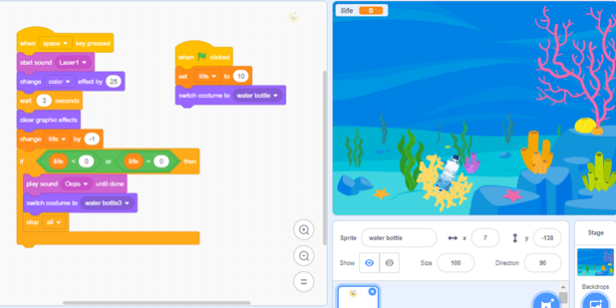
Play the game
Press play in Scratch (click the green flag). Place the objects into the holes (bunched-up pieces of paper can represent plastic waste, or use real pieces of scrap plastic). Using the tweezers, try to extract the objects from the holes without touching the sides. If the sides are touched, the sound will buzz and you lose 1 life. The coral is also changing color for 3 seconds. After you touch the sides of the holes 10 times, the “Oops” music will play and the coral will change to red, meaning that the game is over.
Reflection & Debrief
As a group, discuss the following:
- What happens when the tweezers touch the aluminum paper in the hole? (The circuit is now complete)
- Why is it important to reduce our plastic consumption, especially single-use plastic items?
- Why is it important to preserve the coral reefs?
- Macro plastic pollution versus microplastic (smaller than 5mm) pollution – how does that change the game? What effects on the ecosystem does it have?
- Plastic pollution affects ecosystems all over the world. What might a game based on a different ecosystem look like? e.g., Kelp forest, glass sponge reef or rocky coast
- Make a place-based connection to an ecosystem near participants.
You don’t have to be in the ocean to help. Find a Shoreline Cleanup near you: https://shorelinecleanup.ca/school
Extensions & Modifications
Extensions
- Have the participants build the Scratch program themselves.
- Make more holes with different dimensions to make it harder to grab without touching the sides.
- Reduce the number of lives to 5 instead of 10.
Modifications
- Use the pre-built Scratch program.
- Make larger holes so it’s easier to play the game without touching the sides.
